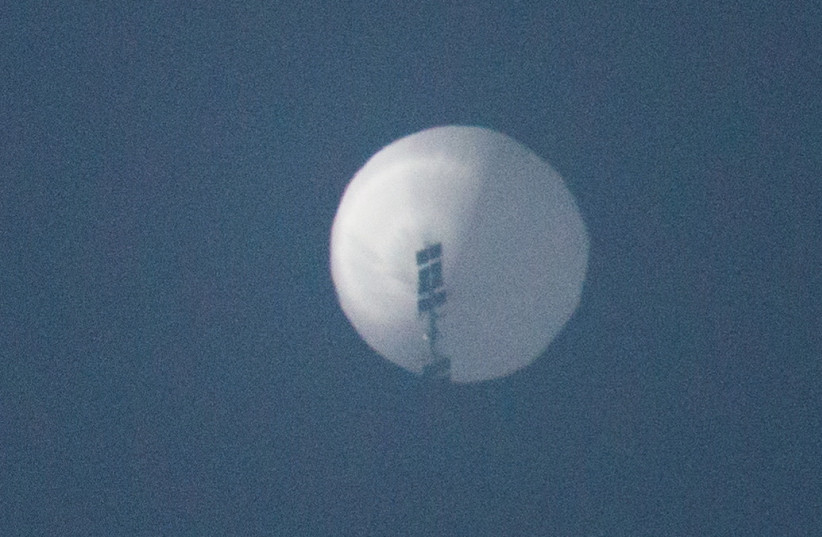US divisions over Chinese spy balloon show politicized foreign policy - analysis

The incursion of a Chinese spy balloon into US airspace has turned what could be a normal debate and discussion into another politicized foreign policy issue.
Political disputes about how to handle an alleged Chinese spy balloon that is drifting over the American Midwest reveal how partisan politics increasingly make foreign policy difficult to conduct in the US.
This has much wider ramifications than one balloon, it goes to the heart of some of the disputes in recent years over foreign policy. These kinds of disputes have also affected Israel, and how some on both extremes of the political spectrum view issues such as Russian aggression in Ukraine, the Iran deal and China.
The Chinese spy balloon was “found” over the northern US late last week and has become a topic of conversation throughout the weekend. “The United States government has detected and is tracking a high-altitude surveillance balloon that is over the continental United States right now,” Pentagon spokesperson Brig. Gen. Pat Ryder told NBC News.
“We continue to track and monitor it closely.” Reuters has said that the “flight of a suspected surveillance balloon over the United States appears to mark a more aggressive - albeit puzzling - espionage tactic than relying on satellites and the theft of industrial and defense secrets,” security experts said.
Apparently, this is not the first time China has used high-altitude balloons like this. “China's recent balloons - a White House official said this week's episode was not the first - have some in Washington scratching their heads,” Reuters noted. "In a way, it's more amateurish," said former White House national security adviser John Bolton. "Do the cameras in their satellites not have high enough resolution that they have to send a balloon over.”
Details missing regarding context and background of balloon incursion
One of the issues that have underpinned this story is a lack of details about precisely how this happened and what is the context and background. A report at NPR noted that “Canada also says it’s monitoring a high-altitude surveillance balloon, though it’s not clear if it’s the same one.
US officials said the balloon they are tracking flew over the Aleutian Islands and through Canada before it was spotted Wednesday over Billings, Montana.” The sense is that these balloons have been tracked this time and in the past and that there are a number of them, including one reportedly over South America.
Controversy has erupted in the US because the government initially decided not to shoot down the balloon. This raises questions about how the US and others have handled these balloons in the past. What are the international norms that underpin balloons like this? Are countries supposed to tell others when a balloon will be traversing over a country? This is not a simple question because it is not clear how far national sovereignty extends into space. In general “near space” is considered the part of the atmosphere from 65,000 feet (around 12 miles) to 186 miles.
One article on the subject notes “this area is above the altitude at which conventional aircraft normally operate and below the closest point to the Earth of the orbit, or perigee, of most satellites.” The Chinese balloon is floating at some 60,000 feet and it is believed to be carrying surveillance and other equipment that some estimated was the size of several school busses. China describes the balloon as a civilian airship and is doing research.
“China is a responsible country. We act in accordance with international law. We have no intention of violating other countries’ airspace. We hope relevant parties would handle the matter in a cool-headed way,” China told CNN. China says that the airship was blown off course by wind and deviated from its course. It’s unclear what that course was supposed to be.
Now the balloon has become a political issue. As critics of the Biden administration’s decision not to neutralize the balloon began to say it should be shot down, the supporters of the administration then began to push back. This has turned what could be a normal debate and discussion into another politicized foreign policy issue. For some, the appearance of the balloon on the eve of US Secretary of State Antony Blinken’s planned visit to China is an example of how possible “détente” with China is being sabotaged.
House China Select Committee Chairman Mike Gallagher told Fox News Digital that the Chinese spy balloon is "not just an isolated incident," but an intentional violation and threat to American sovereignty.” US Senator Marco Rubio also tweeted “It was a mistake to not shoot down that Chinese spy balloon when it was over a sparsely populated area. This is not some hot air balloon, it has a large payload of sensors roughly the size of two city buses and the ability to maneuver independently.”
Speaker of the House Kevin McCarthy also wrote that “China’s brazen disregard for US sovereignty is a destabilizing action that must be addressed, and President Biden cannot be silent.” Representative Jim Jordan wrote “President Trump was tough on China. Biden lets them fly spy balloons over our country.”
It was a mistake to not shoot down that Chinese spy balloon when it was over a sparsely populated areaThis is not some hot air balloon, it has a large payload of sensors roughly the size of two city buses & the ability to maneuver independently
— Marco Rubio (@marcorubio) February 3, 2023
The political aspect of this is now one of the main issues. Former Representative Adam Kinzinger noted that “you can be for shooting down the balloon (I am), but if you’re for it because Joe Biden is president and you think you can make him look bad, then prolly just let the grown ups debate and decide.” The debate has now become even more shrill with some suggesting the balloon could be a trial run for delivering an EMP or a “bioweapon.”
Meanwhile, others have a more level-headed approach. Discussing the balloon, representative Elissa Slotkin wrote “A new and not positive development in the US-China story. Whether they sent the balloon to test our surveillance systems, or as a signal before the now-canceled meetings with Secretary Blinken, it’s a violation of our airspace & only raises tensions in an already tense environment.” She said members of congress should be briefed on how this happened and the response.
Those on the right who suggest shooting the balloon down are being confronted by those who think the US national security establishment is right, that it may be dangerous to shoot it down, or that it isn’t a threat. However, as time goes by and the debate becomes more about politics, and less about the finer details of what has happened, it will become harder for the US to extricate itself from this mess.
This means that if the White House is seen to cave to pressure to “shoot it down” then the opponents of Biden will be seen to have scored a goal; which makes it even less likely that the US might act. On the other hand, there are many questions about why this balloon got so much attention and whether the administration was prepared with messaging on the issue. Others wonder about the timing and the canceled China trip by Blinken.
Overall, the major problem is that like many issues in the US these days, a normal policy debate has been hijacked and potentially skewed. Key questions, such as whether this is in fact a spy balloon, have been lost in the shuffle. It’s very difficult to know what is accurate when politics plays such a major role in decision-making or media discussion. This was a similar trajectory with the Iran deal.
Once the US administration of then-President Obama was locked into wanting the deal it couldn’t be seen to walk away. In essence that meant Iran’s talking points sometimes seemed to be fronted by supporters of the deal, in essence running the ball or playing the role of blocking tackle for Tehran. Opponents of the deal were called pro-war or even portrayed as supporting foreign governments. Iran became a political issue. Today, due to Iran’s backing of Russia, it has lost the excuses it used to get by some voices on the Left.
Ukraine and Russia have also entered into US political debates. Some on the right think US support for Ukraine is too strong and that Russia has somehow been provoked or pushed into a corner. Those who remember the “Russia collusion” controversy tend to be skeptical of some coverage of Russia and Ukraine. As such, some on the right who once opposed Russia during the era of the “reset” have become softer on Moscow. At the same time, some of the Iran Dealers have also become excusers of Moscow’s behavior, and some of them are even into appeasing China. Some on the far left are also into excusing Russia and China. It’s very hard to separate politics from these “hot takes” when people make foreign policy decisions based more on getting back at political adversaries than based on ideology and logic.
The China spy balloon controversy appears to continue to get hot air from the way it has been turned into a political football. This has ramifications for many other issues, whether it is US-Saudi ties or even US-Israel ties. When foreign policy is a political football it is harder for countries to make their case and harder for wisdom to prevail.
Jerusalem Post Store
`; document.getElementById("linkPremium").innerHTML = cont; var divWithLink = document.getElementById("premium-link"); if (divWithLink !== null && divWithLink !== 'undefined') { divWithLink.style.border = "solid 1px #cb0f3e"; divWithLink.style.textAlign = "center"; divWithLink.style.marginBottom = "15px"; divWithLink.style.marginTop = "15px"; divWithLink.style.width = "100%"; divWithLink.style.backgroundColor = "#122952"; divWithLink.style.color = "#ffffff"; divWithLink.style.lineHeight = "1.5"; } } (function (v, i) { });

